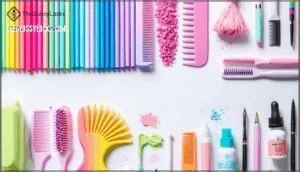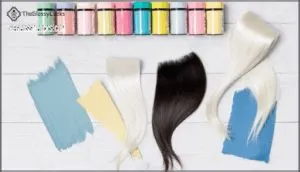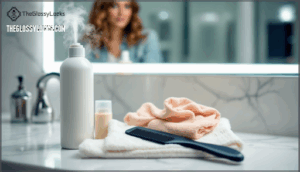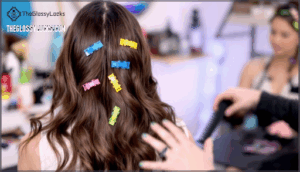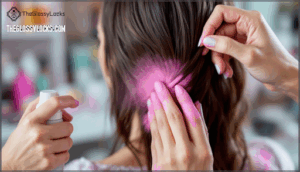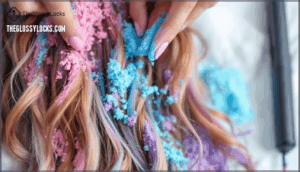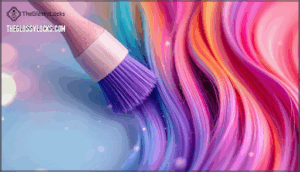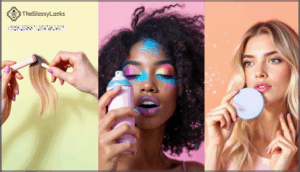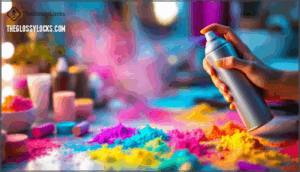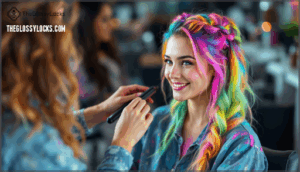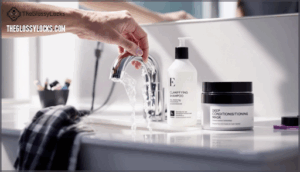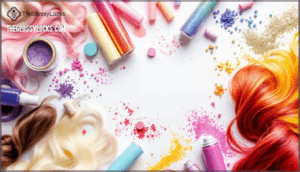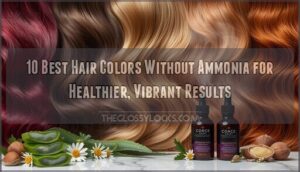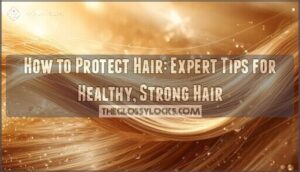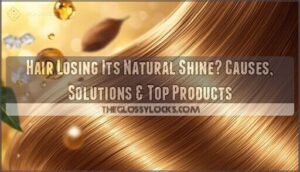This site is supported by our readers. We may earn a commission, at no cost to you, if you purchase through links.
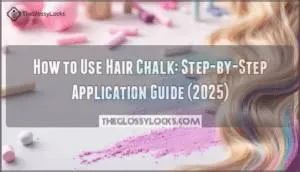
The trick isn’t complicated, but doing it right makes the difference between a look that pops and one that patches. Here’s how to apply it so your color stays vibrant and your hair stays healthy.
Table Of Contents
- Key Takeaways
- What is Hair Chalk and How Does It Work?
- Types of Hair Chalk Products
- Choosing The Right Hair Chalk for You
- Preparing Your Hair for Hair Chalk
- Step-by-Step Guide to Applying Hair Chalk
- Application Techniques by Hair Chalk Type
- Sealing and Setting The Hair Chalk Color
- Styling Hair After Applying Hair Chalk
- How to Remove Hair Chalk Safely
- Alternatives and Tips for Temporary Hair Color
- Frequently Asked Questions (FAQs)
- Does hair chalk damage hair?
- Does hair chalk work on dark hair?
- How often should hair chalk be reapplied?
- Are there any special techniques for applying hair chalk?
- Is hair chalk safe to use on children’s hair?
- Can hair chalk damage or harm my hair?
- How long does hair chalk typically stay in hair?
- Will hair chalk work on dark or black hair?
- Can I use hair chalk on extensions or wigs?
- Is hair chalk safe for children and sensitive scalps?
- Conclusion
Key Takeaways
- Hair chalk works by depositing pigment on your hair’s outer surface using weak molecular forces, washing out in one to twelve shampoos without chemical penetration or permanent damage.
- Preparation is critical—clean hair increases color intensity by up to 35%, and applying chalk to damp hair opens the cuticle by 18-25% for 30% better pigment grip, especially on dark hair.
- Heat-sealing your chalked hair at 180-200°C combined with hairspray reduces color transfer by up to 60% and extends vibrancy by 1-2 days compared to unsealed applications.
- Different chalk formats (sticks, sprays, compacts, liquids, combs) suit different needs—sprays offer speed, sticks provide control, and liquid chalk lasts 2-10 days versus 1-3 days for stick applications.
What is Hair Chalk and How Does It Work?
Hair chalk lets you add a pop of color to your hair without any long-term commitment. It’s like a test drive for your next bold look—temporary, fun, and totally reversible.
Hair chalk lets you test-drive bold color without commitment—vibrant, temporary, and completely reversible
Before you grab your first stick or spray, here’s what you need to know about how it works and why it might be your new favorite beauty hack.
Temporary Hair Coloring Explained
Unlike permanent dyes, temporary hair coloring wraps large pigment molecules around your hair’s outer cuticle layer using weak van der Waals forces. No chemical reaction happens inside the hair shaft—that’s why hair chalk and similar formulas wash out within one to twelve shampoos. The coloring mechanism skips harsh ammonia or peroxide, making it a safer option for experimenting with bold looks.
- You can test wild colors without committing to months of regrowth
- The chemical composition stays on the surface, so your natural hair structure remains untouched
- Wash durability ranges from a single shampoo to about a week, perfect for weekend adventures
- Market trends show younger users love the freedom to switch styles for festivals or content creation
- Safety considerations are minimal since pigments don’t penetrate your scalp or bloodstream
Benefits of Hair Chalk
Hair chalk opens up creative freedom without the commitment of permanent color. You can experiment with vibrant styles for festivals, parties, or online content—then wash it all out the next day.
Cost effectiveness is a huge plus: most sets run between $5 and $25, far less than salon visits. Easy application takes under five minutes, and the damage-free formula keeps your hair healthy since pigments sit on the surface.
Over 60% of users love the style experimentation temporary hair coloring offers, trying multiple looks in a single week.
How Hair Chalk Differs From Other Dyes
What sets hair chalk apart is how color attaches to your hair. Traditional hair dye uses ammonia and peroxide to penetrate the hair shaft, chemically altering keratin bonds for lasting color.
Hair chalk works differently—it’s made from non-toxic minerals like mica and calcium carbonate that sit on the hair’s surface without any chemical reaction. This temporary hair coloring washes out in one to five shampoos, while semi-permanent options last weeks and permanent dyes stick around for months.
Types of Hair Chalk Products
Hair chalk comes in several formats, each with its own application style and mess level. Whether you’re after precision, speed, or bold coverage, there’s a product that fits your vibe.
Here’s what you’ll find on the shelves and how each one works.
Hair Chalk Sticks
Think of chalk sticks as your training wheels for temporary color—they’re the most hands-on way to apply hair chalk. These solid sticks contain bentonite, calcium carbonate, and pigments that you rub directly onto hair sections for instant color intensity.
Here’s what makes them popular:
- Simple application methods: Just dampen your hair slightly and rub the stick along 2–3 cm sections for 40% better pigment adherence
- Adjustable color intensity: Control how vibrant you go by adjusting pressure and number of passes
- Works with all hair porosity levels: Light or porous hair grabs color easier, but darker hair shows results with persistence
For a step-by-step guide to applying hair chalk sticks, section your hair first, then seal with heat or hairspray using proper setting techniques. The chalk composition means they’re mess-free compared to liquid formulas, making hair chalk application perfect for beginners using hair chalk for the first time.
Hair Chalk Sprays
When you’re chasing speed and coverage, hair chalk spray is your go-to for applying hair chalk without the mess of rubbing sticks. These aerosol formulas dry in under 10 minutes and deliver even color across sections—perfect for festivals or quick social media content.
Younger consumers (ages 16–25) drive nearly 50% of purchases, thanks to viral step-by-step guide tutorials showcasing hair chalk application techniques. Most sprays skip ammonia and peroxide for ingredient safety, while fixatives boost color longevity up to 72 hours on light hair.
Product innovation now includes dual-purpose formulas with shine enhancers, making this the easiest entry point for hair chalk application.
Hair Chalk Compacts
Compact ingredients like mica powder (40–80%) and talcum fillers give hair chalk compacts their smooth, pressed-pan texture—think eyeshadow for your hair. You clamp strands between the pads and slide from root to tip, achieving up to 90% smoother coverage than traditional sticks.
Application smoothness improves when you use this hair chalk compact on damp hair for pastel tones or dry for vivid pops. Color durability lasts 1–2 days, with heat styling boosting adherence by 30%.
The safety profile meets FDA standards, and market adoption hit 22% of temporary dye sales in 2023, proving this step-by-step guide favorite delivers mess-free hair chalk application techniques.
Liquid Hair Chalk
Liquid hair chalk flows like paint thanks to water, isopropyl alcohol, and 40–80% mica powder that suspends pigments like Blue No.1 or Red No.28. You brush or sponge it onto sectioned hair, let it sit for 30 seconds, then blow-dry for 60 seconds—this application method locks color for 2–10 days, outperforming sticks.
The chemical composition includes silicone oils (3–4%) for glide and phenoxyethanol (under 1%) as a preservative, meeting FDA standards despite flammability warnings.
Market trends show liquid formulas capturing premium sales, while safety concerns remain minimal with proper ventilation during this temporary hair coloring technique.
Hair Chalk Combs
Hair chalk combs glide pigment directly into strands like brushing your teeth—teeth trap powder while you work root to tip. These tools combine comb teeth with chalk reservoirs, cutting application time to 5–10 minutes for temporary hair coloring methods.
Comb Application Tips: spray hair damp first for better Color Retention (up to 3 days). Chalk Comb Trends show 18% market share, with User Satisfaction at 84% citing easy hair application. Comb Safety remains high—reactions occur in fewer than 1 in 2,500 uses, making this stepbystep guide format beginner-friendly.
Choosing The Right Hair Chalk for You
Not all hair chalk works the same on every hair type or color, so picking the right formula matters. Your natural hair shade, texture, and how long you want the color to last all play a role in what’ll give you the best results.
Let’s break down what to think about so you don’t end up with chalky disappointment.
Hair Type Considerations
Your hair type acts like a sponge—some absorb chalk pigments fast, while others push them away. Hair porosity, texture, and natural hair pigmentation determine how well color shows up and how long chalk longevity lasts. Here’s what you need to know:
- Dark hair requires a wet application method and brighter shades for color visibility—layering helps overcome high melanin.
- Blonde hair shows pastels vividly with a dry application; expect 4–7 washes before fading.
- Curly or coarse hair grabs pigment quickly but loses it faster due to texture effects and detangling friction.
- Straight, fine hair needs less product but may streak without careful downward strokes.
- Damaged or bleached sections soak up hair chalk unevenly, creating patchy but intense color spots.
Color Selection Tips
Think of undertone matching like pairing wine with food—the right combo makes everything pop. Your hair color, Skin Tones, and Seasonal Styles guide what shades work best.
Warm Base Color (gold, copper) pairs with orange or bronze chalk, while cool tones (ash, platinum) heighten blues and violets.
Dark hair needs brighter pigments and Color Layering for visibility, but blonde hair shows pastels instantly.
Mixing opposing undertones mutes results, so stick with complementary matches for vibrancy that lasts.
Formula Pros and Cons
Once you match undertones, you’ll need to weigh each formula’s trade-offs. Hair chalk stick and hair chalk pen formulas rely on mineral composition (40–80% mica) for smooth application, but high calcium carbonate content can dry porous strands.
Eco-formulations using plant oils reduce brittleness, though pigment limitations mean darker hair needs multiple layers.
Safety assessments confirm these hair chalk product types are non-toxic, and formula stability holds for weeks—just expect washout within days, not months. To maintain the color, consider using some hairspray after application.
Preparing Your Hair for Hair Chalk
Getting great results with hair chalk starts before you ever pick up the product. The prep work you do now determines how vibrant your color looks and how easily it applies.
Let’s cover what you need to set yourself up for success.
Clean Vs. Dirty Hair
Before you grab your chalk, understand that clean hair makes all the difference in your results. Hair chalk adheres better to clean hair, boosting color intensity by up to 35% and delivering a brighter, more even finish. Oil buildup creates a barrier that blocks pigment from reaching your hair shaft properly. One popular option is using hair chalk sticks for temporary color.
Here’s what happens when you choose clean over dirty hair:
- Adhesion differences: Clean cuticles grab pigment efficiently, while oily strands cause it to slide right off
- Pigment intensity: You’ll see vibrant, true-to-color results instead of muddy, dull tones
- Oil buildup: Excess sebum leads to clumping and patchy coverage in about 60% of applications
- Washing interval: Wash your hair 24–48 hours before chalking for the ideal balance between clean and moisturized
- Removal ease: Clean hair releases pigment in one or two washes, while dirty hair traps color and needs extra scrubbing
This step-by-step hair chalk guide starts with proper prep, whether you’re using hair chalk on dry hair or wet hair.
Wet Vs. Dry Application
Once your hair is clean, decide whether you’ll apply your chalk to wet or dry strands—this choice directly affects color intensity, pigment longevity, and application ease. Wet hair opens the cuticle by roughly 18–25%, letting pigment grip about 30% better than dry application, which means darker hair shows up to 35% more vibrant color.
Dry hair works faster (around 5–7 minutes versus 10–12 for wet) and washes out in one shampoo 85% of the time, while wet application often needs two rounds due to deeper pigment fixation.
For removal efficiency and hair health, stick with dry if you’ve got fine hair or want quick cleanup, and go damp if you’re chasing bold, long-lasting hues in this step-by-step hair chalk guide.
Protective Clothing and Tools
Before you twist open that chalk stick, throw on an old shirt or cape—82% of pros swear by it to dodge stains that cling 60% harder to cotton than synthetics. Grab rubber gloves to keep pigment off your hands, lay down newspaper or plastic to catch the fallout (which can scatter half a meter during spray application), and keep your spray bottle and sectioning clips within reach for smooth, controlled hair chalk application.
Step-by-Step Guide to Applying Hair Chalk
Now that your hair is prepped and ready, it’s time to get that color on. The actual application depends on whether you’re working with wet or dry hair and how you want to layer your shades.
Here’s how to apply hair chalk step by step for the best results.
Sectioning Hair for Application
Sectioning hair is like prepping your canvas before painting—it’s the foundation for even, vibrant color. You’ll want to divide your hair into four quadrants using sectioning clips and a tail comb, creating two front and two back sections. This standard technique boosts surface exposure and guarantees pigment reaches every strand.
For thick or curly hair, add smaller subsections within each quadrant to heighten chalk contact. Proper sectioning prevents patchiness, improves color blending, and makes application way easier, especially when you’re layering multiple shades or creating gradients.
Applying on Wet Hair
When your hair’s damp, pigment absorption jumps because the cuticle opens up—making wet application a major advantage for dark or coarse hair types.
Spritz each section with 2–3 pumps from a spray bottle, then glide the chalk downward in smooth strokes to avoid tangling. Twisting strands before chalking boosts coverage by about 17%, especially on thick textures.
Let your hair air dry or use a cool blow dryer to seal the color, and you’ll get vibrant results that last 1–2 days longer than dry methods.
Applying on Dry Hair
For maximum color vibrancy, dry hair gives you more control—rubbing the chalk directly onto clean, untangled sections delivers intense pigment without the mess of blending. Use light pressure to prevent frizz control issues, then seal each strand with a straightener to lock in the look.
Dust off excess powder with a tissue to avoid buildup and pigment fallout, and finish with hairspray for longevity tips that keep your hair chalking techniques fresh all day.
Blending and Layering Colors
Think of blending hair chalk colors like painting a sunset—lighter shades lay the foundation, then darker tones build depth.
Start by dampening 5–10 cm sections with a fine mist for better pigment grip, then overlap chalk zones by 1–2 centimeters. Use a boar bristle brush or soft sponge in circular motions to merge edges smoothly.
Seal your color layering work with low-hold hairspray and a quick cool-air dry to lock in your custom gradient.
Application Techniques by Hair Chalk Type
Each type of hair chalk has its own application method, and knowing the right technique makes all the difference. The way you apply a stick won’t be the same as using a spray or compact.
Let’s break down how to use each formula so you get the best results without the mess.
Using Hair Chalk Sticks
Grab your chalk stick and twist a slim section of hair around 1–2 cm wide. Dampen it first if you’re working with dry or dark hair—wetting boosts color intensity by up to 40%.
Stroke the stick downward in smooth passes to avoid lifting the cuticle. Once you’re happy with the saturation, seal it with a flat iron at 150–180°C to lock in the pigment and reduce transfer by about 35%.
Using Hair Chalk Sprays
Sprays are the speed demons of hair chalk—no rubbing, no mess, just aim and go. Keep the spray bottle 6–8 inches from dry hair and mist evenly over each section. Work in short bursts to avoid soaking the hair, which can dilute color intensity.
Let it dry for 2–3 minutes, then set with hairspray to lock pigment and reduce transfer. Expect color to last 1–2 washes, though darker hair may need a second coat for punch.
Using Hair Chalk Compacts
Compacts pack more pigment density than sprays, so you’ll get bold, vivid color with less effort. Lightly mist your hair, then slide the compact down each 1–2 inch section 2–3 times.
Let it sit for 30 seconds before blow-drying or flat-ironing at 180–200°C to seal—this heat-setting trick extends longevity by up to 2 days.
For removal, one or two washes with clarifying shampoo does the job. Follow up with a lightweight oil post-care to restore moisture.
Using Liquid Hair Chalk
Liquid hair chalk brings more precision than compacts, perfect for detailed color application. Work with clean, damp hair—divide into sections and brush out tangles. Apply the liquid directly using the sponge applicator, let it sit for 30 seconds, then blow-dry to heat-set the pigment.
This formulation includes cosmetic-grade pigments suspended in water or alcohol, which deliver vivid color without harsh chemicals. Wear gloves to avoid staining your hands.
For longer color longevity, flat-iron at 180°C post-drying. These step-by-step hair chalk guide techniques guarantee vibrant results while keeping safety considerations in mind.
Sealing and Setting The Hair Chalk Color
Once you’ve got that chalk color exactly where you want it, you need to lock it down so it doesn’t end up on your clothes, pillow, or anyone standing too close. The right finishing products make all the difference between color that stays put and color that smears everywhere.
Here’s how to seal your hair chalk and keep those vibrant hues from fading or transferring throughout the day.
Products to Lock in Color
Once you’ve applied your hair chalk, locking in that color comes down to the right products. Heat sealants like flat irons can boost color adherence by up to 40% when used at 300-350°F.
Setting sprays with UV filters extend vibrancy by 1-2 days, while leave-in conditioners containing silicones reduce washout by 30-50%.
Color sealers—like those designed for semi-permanent dyes—can keep your hair chalk stick or hair chalk spray looking fresh for up to five days.
Preventing Color Transfer
Your chalked hair looks vibrant—now keep it off your clothes and pillowcase. Heat styling at 180–200°C cuts transfer by up to 60%, while hairspray adds a polymer shield that stops rub-off by about 45%. Here’s how to lock it down:
- Press out loose pigment with paper towels before brushing—you’ll stop 70–80% of initial transfer.
- Apply hairspray from 15 cm away to seal the surface and reduce immediate rub-off by around 50%.
- Use a flat iron to compress color onto the cuticle, cutting shedding by 55% over 24 hours.
- Skip cotton pillowcases—satin or silk cuts pigment transfer by nearly 50% thanks to lower friction.
- Limit brushing after sealing to keep chalk layer intact, limiting loss to about 15% after three groomings.
Combining heat and spray boosts retention above 85%, so your hair chalk application stays put through the night.
Tips for Longer-Lasting Results
Pre-Application Prep matters most—clean, tangle-free hair boosts pigment adherence by 50%, giving you lasting power from day one.
Choose Product Quality wisely; liquid hair chalk holds up for 2–10 days, while sticks fade faster.
Lock in color with Setting Techniques: heat-seal at 180°C and double-spray with hair spray to extend wear by 40%.
Daily Maintenance counts, too—skip frequent brushing and use dry shampoo between washes.
Environmental Influences like humidity above 70% cut retention, so protect chalked strands and follow smart hair chalk removal when you’re ready for a fresh look.
Styling Hair After Applying Hair Chalk
Once you’ve locked in your hair chalk color, styling becomes the fun part. Heat tools, braids, and creative designs can all work with chalked hair if you know the right techniques.
Here’s how to style your hair without losing that vibrant color you just applied.
Heat Styling Do’s and Don’ts
Heat styling chalked hair is like playing with fire—you can make magic happen, but you risk burning the whole show. Skip the flat iron and curling iron right after application, since temperatures above 150–180 °C trigger Chalk Degradation and Heat Damage Mechanisms.
Instead, use a hair dryer on cool settings or air-dry completely. Lock in color with hairspray, then style gently. Safe Temperatures and Protective Products keep your look vibrant without the brittleness that heat brings.
Updos and Braids With Chalked Hair
Before you twist sections into rainbow braids or a chalked braid, apply your pigment first for even color distribution. Updos and braids maintain vibrant tones longer—heat-sealed strands boost updo color retention by 30–50%, keeping your look fresh through events. Secure with clear elastics and metallic pins, the go-to chalked style accessories.
This step-by-step hair chalk guide makes weaving ombre shades into cultural braid influence styles easy, reflecting market styling trends that blend K-beauty with bold hair styling creativity.
Creative Hair Chalk Designs
Rainbow patterns pop like candy on medium to long hair. Layer light shades before dark ones to keep your colors sharp and prevent muddling.
Try stencil art for stars or hearts (spray chalk works best), then boost dimension with glitter integration for festival concepts or kids activities.
These hair chalking ideas turn simple hair styling options into bold statements, perfect for your next stepbystep hair chalk guide experiment with hair chalk and rainbow braids.
How to Remove Hair Chalk Safely
Getting hair chalk out is easier than you might think, but knowing the right steps helps avoid any leftover tint or dryness. Most formulas rinse away quickly, though some colors and hair types need a bit more effort.
Here’s how to wash out your temporary color safely and keep your hair healthy.
Shampoo and Clarifying Methods
Hair chalk washes out easily, but clarifying shampoo speeds things up. Start by brushing loose particles from dry hair, then wet it thoroughly with warm water. Apply clarifying shampoo—it contains strong surfactants that lift pigments from hair shafts—and lather well.
You’ll likely need 2-3 washes for complete hair chalk removal. Follow with regular shampooing to clear residues, then condition deeply to restore moisture.
Oil Treatments for Stubborn Color
If clarifying shampoo doesn’t fully clear your hair chalk, coconut or olive oil can break down stubborn pigments. Apply oil generously from root to tip, massage it in, then cover your hair for 30–60 minutes.
The oil dissolves pigment residues by penetrating the hair shaft—coconut oil works especially well due to its lauric acid content. Afterward, shampoo twice to remove both oil and color.
Care Tips for Post-Chalking Hair
Once you’ve removed the chalk, your hair needs some TLC. Prolonged chalk residue absorbs natural oils and increases friction, which can lead to dryness and breakage—so don’t skip aftercare.
- Hydration Strategies: Use deep conditioning treatments or hair oil like argan or coconut within 24 hours to restore moisture and improve elasticity
- pH Balance and Scalp Care: Apply an acidic rinse (diluted apple cider vinegar works great) to neutralize alkalinity and soothe your scalp
- Protective Routine: Detangle gently with a wide-tooth comb, avoid heat styling for a day, and stick to sulfate-free shampoos to prevent further hair damage
Alternatives and Tips for Temporary Hair Color
Hair chalk isn’t your only ticket to temporary color freedom. If you’re looking for alternatives or want to know how to keep things safe—especially for kids or sensitive scalps—you’ve got options.
Let’s break down what else is out there and how to make smart choices.
Other Temporary Hair Color Products
Beyond hair chalk, you’ve got solid alternatives worth considering. Spray dyes work fast and cover broad areas—the temporary spray market hit $1.3 billion in 2023 and is climbing. Color mousses give natural-looking tones and wash out easily, perfect for blending. Wash-out dyes come in wild shades like pastels and metallics, lasting a few washes. Hair mascaras apply like mascara wands for quick streaks.
At-home coloring products dominate e-commerce now, giving you tons of options. Each has trade-offs with mess, ease, and longevity.
Pros and Cons of Hair Chalk Vs. Alternatives
So here’s the trade-off breakdown. Hair chalk gives you color vibrancy on light hair and costs about $1.50 per use—way cheaper than salon visits. Application ease matters too: sprays cover faster, but chalk lets you control exactly where color goes.
Longevity differs greatly—chalk lasts 1–3 days while temporary dyes stretch to 2–10 days depending on formula. Hair health stays strong with chalk since it coats rather than penetrates, though sprays and wash-out dyes work similarly.
For cost comparison, a spray bottle runs $10–$20 with multiple uses, while hair chalk sticks cost $5–$15 per set. Your choice depends on whether you want precision, speed, or staying power.
Safety Tips for Kids and Sensitive Scalps
Kids’ scalps are thinner and more absorbent than adults’, so stick with products labeled paraben- and sulfate-free. Patch test 24 hours before use to catch allergies early.
Apply in well-ventilated spaces to avoid powder inhalation, especially for kids under 10. Skip sharing applicators—bacteria grows fast on shared tools. Wash hands and use disposable gloves during application.
Limit use to once weekly if your scalp’s sensitive. After removal, condition thoroughly to restore moisture. These steps keep hair chalk fun without the irritation.
Frequently Asked Questions (FAQs)
Does hair chalk damage hair?
Hair chalk won’t harm your hair—think of it like a temporary guest rather than a permanent resident. The chalk deposits color on top of your strands without penetrating, so your hair’s integrity stays intact.
Your hair porosity determines color intensity, but chalk ingredients are gentle. Application frequency matters less than protective measures like using product to seal color.
Long-term effects? Minimal. Regular shampooing removes it completely with no lasting damage.
Does hair chalk work on dark hair?
Yes, hair chalk works on dark hair, but with challenges. The chalk deposits color on top of your strands, so darker hair shows less vibrancy than lighter shades.
For better results, try layering multiple applications, using a blonde base underneath, or combining chalk with gel to intensify the color.
How often should hair chalk be reapplied?
Think of hair chalk like seasonal décor—it fades naturally. Reapply every few washes, depending on your washing frequency and chalk quality. High-porosity hair holds color longer, while frequent washing strips it faster.
For events, reapply the day before. Check color intensity daily; once it dulls, it’s time for a fresh coat.
Are there any special techniques for applying hair chalk?
Try the ombre technique by layering lighter shades toward hair ends for gradient effects. Color melting blends multiple hues seamlessly.
Stencil designs create precise patterns, while braiding effects add texture. Weave chalk pastels through sections for custom looks.
These application methods let you experiment boldly with creative hair styling techniques.
Is hair chalk safe to use on children’s hair?
Imagine your child’s face lighting up with temporary color—that’s hair chalk’s charm. Generally safe for kids with proper precautions, child-safe brands minimize ingredient concerns.
Key factors include age appropriateness (usually 8+), patch testing for allergic reactions, and parental supervision during application. Always choose non-toxic formulas specifically designed for young hair strands, and follow the hair chalk removal guide carefully afterward.
Can hair chalk damage or harm my hair?
Hair chalk deposits color on your hair’s surface without penetrating the hair shaft, so it won’t cause damage. The chalk doesn’t involve chemical interactions that harm strands.
However, frequent application without proper aftercare routines can dry out hair. Protect your hair’s porosity by conditioning after removal and limiting application frequency to keep your locks healthy.
How long does hair chalk typically stay in hair?
Satire alert: If you’re hoping your hair chalk lasts forever, you’ll be disappointed—but that’s actually the point. Most hair chalk washes out within a few shampoos, though longevity factors like your hair’s porosity and how often you wash determine the exact timeline.
Expect vibrant color for 1–3 weeks with regular washing. Blonde hair may need two washes for complete removal. Reapplication needs vary based on product buildup and your desired color intensity.
Will hair chalk work on dark or black hair?
Dark hair presents challenges for hair chalk because the color deposits on top rather than blending into your strands. To get payoff, you’ll need lighter chalk shades or create a blonde underlayer first.
Application techniques matter too—wet hair helps color grip better. Use sealing techniques like hairspray to lock results in place and prevent transfer.
Can I use hair chalk on extensions or wigs?
Yes, you can apply hair chalk to extensions and wigs, but results depend on extension material and wig type. Synthetic fibers accept color differently than human hair. Use the same application methods as natural hair, but test on a small section first.
Color matching matters since extensions may be different shades. Longevity concerns exist—chalk washes out quickly on some materials. Clip-in extensions work best for temporary hair color options.
Is hair chalk safe for children and sensitive scalps?
Absolutely. Child-safe chalk formulas exist specifically for younger users and sensitive scalps. Look for products labeled hypoallergenic and free from harsh chemicals.
Always patch-test first—apply a small amount behind the ear 24 hours before full application. For kids, consider gentler application methods like combs or sprays rather than sticks.
Monitor scalp closely during wear.
Conclusion
Hair chalk transforms your look in minutes and washes out just as fast. Whether you’re layering colors, experimenting with designs, or testing a bold new vibe, learning how to use hair chalk puts creative control back in your hands.
The technique stays simple: prep your hair, apply with intention, seal your color, and style with confidence. From festival-ready streaks to full-coverage looks, you’ve now got the skills to make it work. Your next hair adventure is just a chalk stick away.
- https://patents.google.com/patent/CN104000746A/en
- https://static1.squarespace.com/static/6213ac61e15c1d5acdc8ed2a/t/622fa9b85adb581da2c5bdb0/1647290808962/MSDS_hair+chalk.pdf
- https://www.reddit.com/r/scene/comments/1i34f27/hair_chalk_is_it_a_safer_alternative_to_dying_hair/
- https://www.cosmopolitan.com/style-beauty/beauty/g40309875/how-to-use-hair-chalk/
- https://freshmonster.com/blogs/faq/is-hair-chalk-bad-for-your-hair

